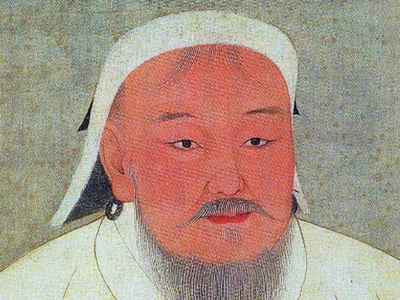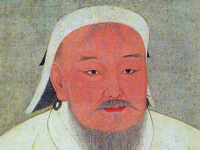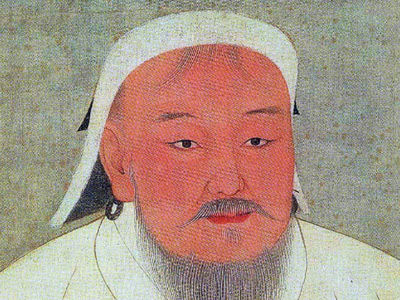Genghis Khan (1162-1227)

Early Life
Little is known about Temüjin's early life, due to the lack of contemporary written records. The few sources that give insight into this period often contradict.
Temüjin's name was derived from the Mongol word temür meaning "of iron", while jin denotes agency thus temüjin means "blacksmith".
Temüjin was probably born in 1162 in Delüün Boldog, near the mountain Burkhan Khaldun and the rivers Onon and Kherlen in modern-day northern Mongolia, close to the current capital Ulaanbaatar. The Secret History of the Mongols reports that Temüjin was born grasping a blood clot in his fist, a traditional sign that he was destined to become a great leader. He was the second son of his father Yesügei who was a Kiyad chief prominent in the Khamag Mongol confederation and an ally of Toghrul of the Keraite tribe. Temüjin was the first son of his mother Hoelun. According to the Secret History, Temüjin was named after the Tatar chief Temüjin-üge whom his father had just captured.
Yesukhei's clan was Borjigin, and Hoelun was from the Olkhunut sub-lineage of the Khongirad tribe. Like other tribes, they were nomads. Temüjin's noble background made it easier for him to solicit help from and eventually consolidate the other Mongol tribes.
Early Life and Family
Temüjin had three brothers Hasar, Hachiun, and Temüge, one sister Temülen, and two half-brothers Begter and Belgutei. Like many of the nomads of Mongolia, Temüjin's early life was difficult. His father arranged a marriage for him and delivered him at age nine to the family of his future wife Börte of the tribe Khongirad. Temüjin was to live there serving the head of the household Dai Setsen until the marriageable age of 12.
While heading home, his father ran into the neighboring Tatars, who had long been Mongol enemies, and they offered him food that poisoned him. Upon learning this, Temüjin returned home to claim his father's position as chief. But the tribe refused this and abandoned the family, leaving it without protection.
For the next several years, the family lived in poverty, surviving mostly on wild fruits, ox carcasses, marmots, and other small game killed by Temüjin and his brothers. Temujin's older half-brother Begter began to exercise power as the eldest male in the family and would eventually have the right to claim Hoelun (who was not his own mother) as wife. Temujin's resentment erupted during one hunting excursion when Temüjin and his brother Khasar killed Begter.
In a raid around 1177, Temujin was captured by his father's former allies, the Tayichi'ud, and enslaved, reportedly with a cangue (a sort of portable stocks). With the help of a sympathetic guard, he escaped from the ger (yurt) at night by hiding in a river crevice. The escape earned Temüjin a reputation. Soon, Jelme and Bo'orchu joined forces with him. They and the guard's son Chilaun eventually became generals of Genghis Khan.
At this time, none of the tribal confederations of Mongolia were united politically, and arranged marriages were often used to solidify temporary alliances. Temüjin grew up observing the tough political climate, which included tribal warfare, thievery, raids, corruption, and revenge between confederations, compounded by interference from abroad such as from China to the south. Temüjin's mother Hoelun taught him many lessons, especially the need for strong alliances to ensure stability in Mongolia.
HISTORY

RESOURCES
This article uses material from the Wikipedia article "Genghis Khan (1162-1227)", which is released under the Creative Commons Attribution-Share-Alike License 3.0.
© Stories Preschool. All Rights Reserved.








